We’ve reached a point where the unprecedented is expected. Even the most well-established businesses cannot expect continued growth, they need to be proactively pursuing growth at all times.
In this environment, more than ever before, a carefully constructed growth marketing plan is an essential part of achieving business objectives. Whether you have an established plan that simply requires fine-tuning or you’re building a plan from scratch, this updated guide to building a growth marketing plan will help you get clarity on the steps you need to take for real, tangible, business growth.
What is a growth marketing strategy?
Rather than fixating on one stage of your funnel, growth marketing focuses on the customer journey as a whole. It is a long-term strategy that is as focused on building customer relationships and fostering loyalty as it is on awareness and acquisition.
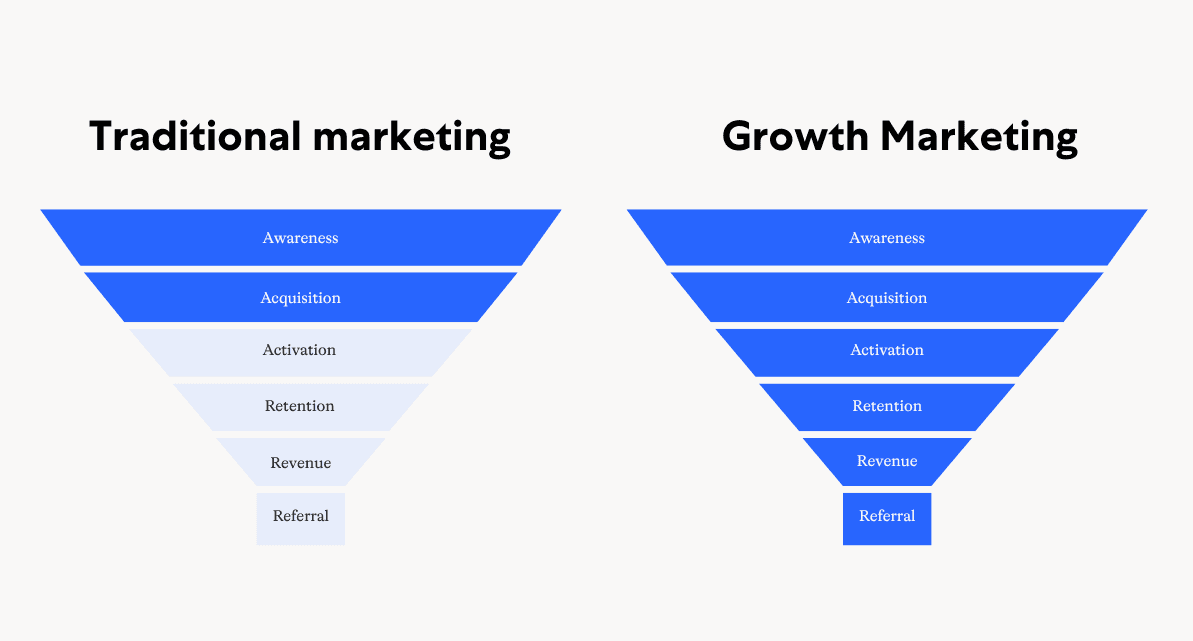
At every stage of the customer journey, a growth marketing plan will analyze data to generate insights that inform strategic initiatives. To quickly learn from and iterate on these initiatives, leaders need to build a culture that celebrates creative problem-solving, experimentation, and agility.
Traditional marketing vs. growth marketing
Typically, traditional marketing focuses largely on top-of-the-funnel activities that drive awareness and acquisition. Annual marketing calendars and plans are the norm and things tend to remain unchanged regardless of performance.
Growth marketing puts the customer at the center of the experience, and markets to them at every stage of the funnel. Rather than driving towards the singular goal of increased revenue from new business, growth marketing looks at whole business growth, including retention and advocacy. If a strategic initiative is underperforming, growth marketing teams quickly analyze results and make optimization decisions to improve performance, or abandon the initiative altogether and move on to something else.
In a recent Forbes article, Senior Contributor John Hall summarized, “Businesses that implement growth marketing aren’t necessarily focused on increasing revenue through individual sales of products and services. Instead, growth marketers concentrate on the customer base. They’re interested in growing that base, retaining the customers that become a part of it, and building a reputable brand. With a growth marketing approach, sales increase through personalized outreach to leads, current customers, and referrals.”
While in the short-term a decrease in the number of new leads or customers can be difficult for a business to stomach, in the long-term it can pay off with cost-per-lead decreasing and overall revenue increasing. As Hall points out, “acquiring new customers can be five times more expensive than retaining the ones you already have. And those who are loyal to your brand will spend up to 57% more.”
Ansoff’s matrix: The four growth strategies for macro business growth
In growth marketing, the Ansoff matrix is often used as a tool for identifying opportunities for macro business growth. It’s a simple framework, developed by applied mathematician and business manager H. Igor Ansoff, that helps leaders identify, develop and articulate their strategies for revenue growth.
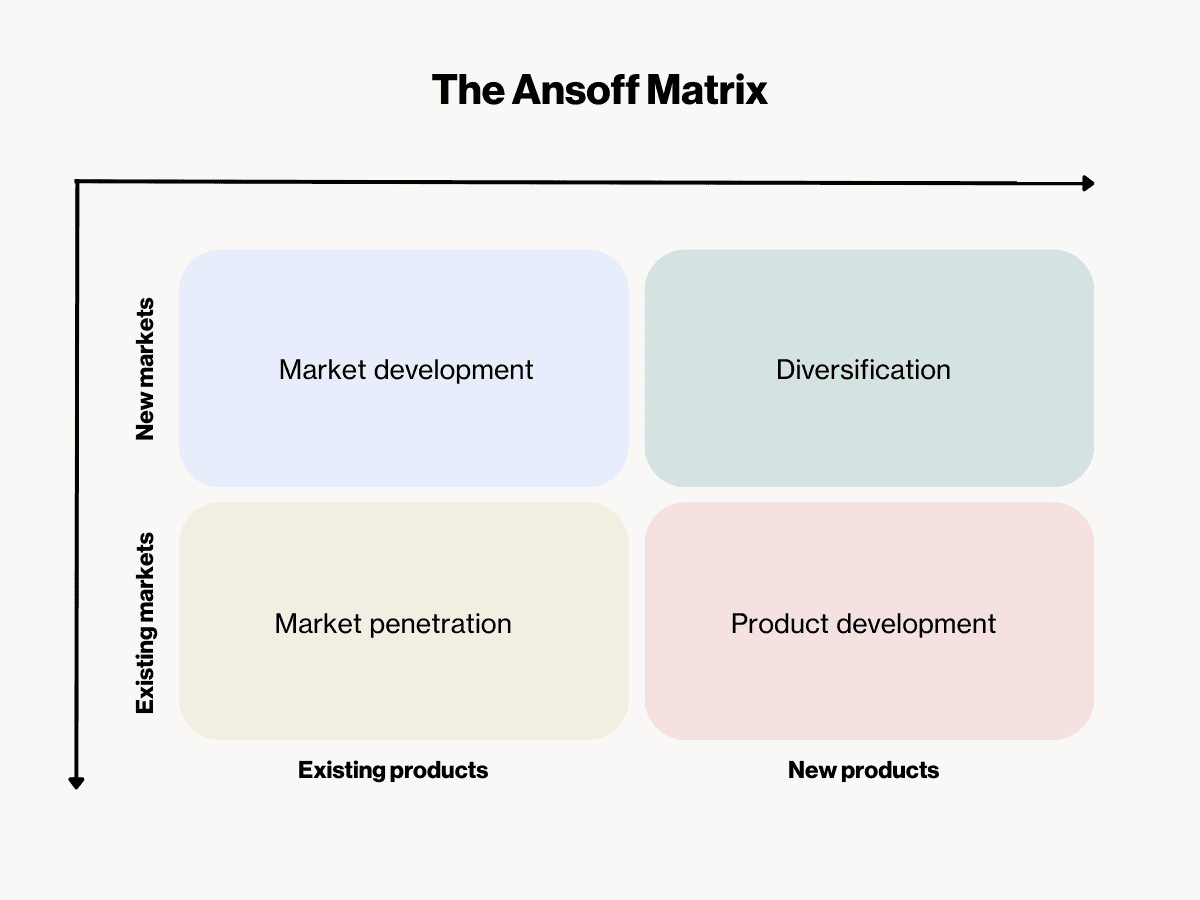
Market penetration
Identified as the lowest risk of the four strategies, market penetration is about growing the distribution of existing products within existing markets. In other words, you sell more of what you have to your existing ideal customer.
This can be achieved by decreasing prices, increasing promotion and advertising, or acquiring another business in the same market. Alternatively, partnering with a company targeting the same market as your brand, but offering a different product or service, can be a way forward. For example, a B2B SaaS company may partner with a B2B agency with each referring the other’s business to their customers.
Market penetration may be a safer bet than other strategies, and it is often a great place to start growing. But it is also quite limited especially if you service a particularly niche market, your pricing model is fixed, or your product does not require re-purchase.Product development
This refers to developing new products that cater to your existing market. One of the advantages of this approach is that you can use your existing customer base to identify the problem a new product could solve, market the solution directly to them, and accurately forecast the adoption of the new product.
In the best cases, a new product opportunity will become apparent organically. For example, you might notice that your existing customers are using another product in conjunction with your own and you have an opportunity to build something similar (but better). Or your customers could be actively requesting you bring something to the market.
However the idea comes to light, building from scratch is not the only option. Many businesses will instead choose to purchase IP, brand generic products, or work in collaboration with a business partner.Market development
With market development, a business will expand into a new market. For example, you could market your existing product in a new country or adjust your marketing strategy to appeal to a wider audience.
Reaching a new market can be tricky, especially if your products and marketing initiatives have been developed with a specific market in mind. It’s important not to steer too far from your existing market, as doing so could result in such a drastic change in tact and messaging that you lose some of your existing market.
Market development typically requires some upfront investment to develop a strategy around the new market, make any required changes to creative and messaging, and spend on target advertising.Diversification
A diversification strategy will see your business develop a new product and enter a new market. It is the riskiest growth strategy, but it also has the most potential for reward.
To succeed in diversification, it’s important to explore related products and markets. In other words, to take what you know and apply it to something new. It’s also best to consider how you can use your existing business structure, process, and team in your diversification efforts. In other words, if you’re a B2B SaaS, diversifying with a physical, consumer-focused product is unwise.
A growth marketing plan may include one major opportunity identified in the Ansoff matrix, along with a number of smaller opportunities for growing throughout the existing marketing funnel.
Benefits of growth marketing
By and large, the biggest benefit of growth marketing is that growth happens at every stage of the funnel. Rather than acquiring a large volume of new customers or leads who eventually churn, you are focused on acquiring and retaining customers who go on to become advocates for your brand. Other benefits include:
Build a data-driven, results-oriented culture
One of the hallmarks of a growth marketing plan is that every decision is driven by data. When data informs the initiatives that are prioritized and decisions that are made, you create data-literate marketers who are aware of how their work impacts the business. This doesn’t just lead to better marketing, it makes for happier, more well-rounded marketers and can help uncover missed opportunities.
Bring more ideal customers into the funnel — and retain them
When marketing is tasked with bringing in more leads, they will go all in on strategies that focus on quantity over quality. For example, if a lead generation ad is driving a high volume of low-cost leads, marketing will double down. Six months later, they could discover these leads started to churn because the messaging was misleading or the targeting was too broad.
In growth marketing, the entire funnel is considered and marketing will be incentivized to pursue campaigns and tactics that generate leads that fit their ICP. Those leads gained today will be retained and primed to expand in the future, contributing to greater business growth overall.
Increase ROI and every other important business metric
Since a growth marketing plan focuses on all parts of the funnel, your attribution model and return on investment (ROI) calculations will take the long-term value of the customer into account. Once marketing activities start bringing higher-quality customers into the funnel, your ROI will start to soar and more budget will be unlocked to continue expanding on or experimenting with growth strategies. Every other business metric, including customer lifetime value (CLV), monthly recurring revenue (MRR), churn rate, and activation rate will be more likely to improve along with it helping your business to tell a positive growth story.
What is the AARRR framework?
When we talk about a growth marketing plan serving every part of the funnel, we are referring to the AARRR framework — an approach developed by venture capitalist Dave McClure to map the customer journey and optimize every step.
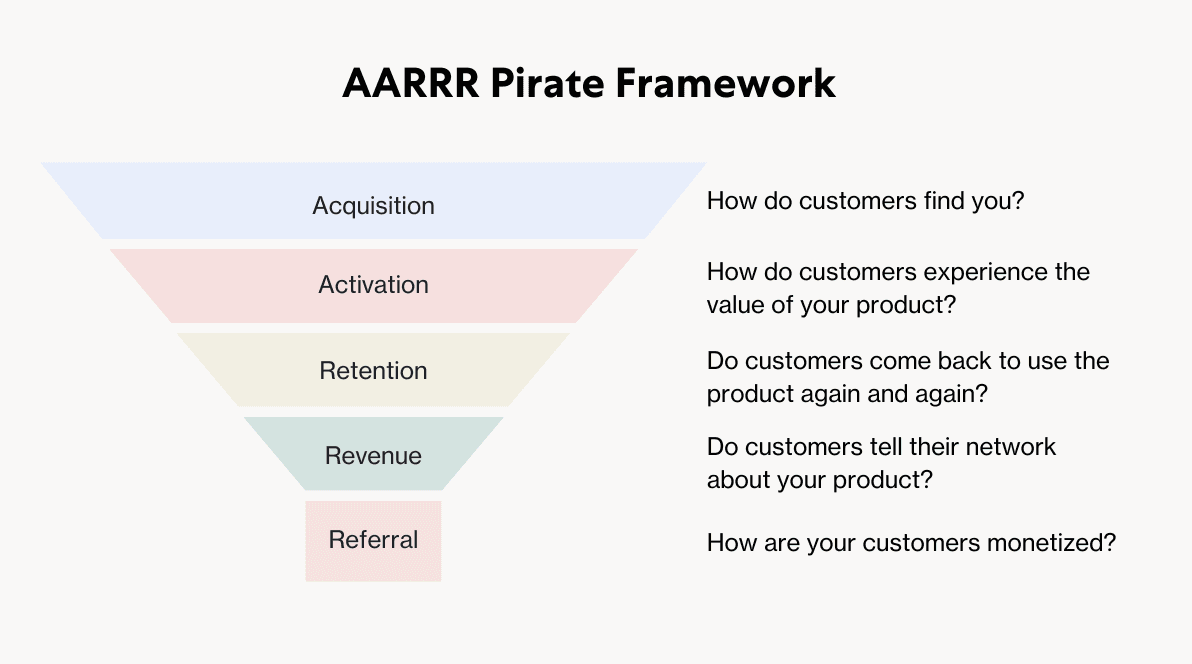
The five stages that build out the AARRR funnel, or the ‘pirate funnel,’ are:
Acquisition: How do customers find you?
Activation: How do customers experience the value of your product?
Retention: Do customers come back to use the product again and again?
Referral: Do customers tell their friends and colleagues about your product?
Revenue: How are your customers monetized?
Here’s how growth marketing commonly plays out across each stage of the funnel:
Acquisition
Goal: Turn page browsers into leads and customers
Metrics to track: New sign ups, cost per lead (CPL)
Tactics and strategies: SEO, demand generation content, paid ads, social media content, and partnerships, lead nurture journeys
Activation:
Goal: Help new customers reach value realization (their ‘aha’ moment)
Metrics to track: Activation rate, Time to first key action, User engagement metrics
Tactics and strategies: Welcome email journey, tooltips and product tours, gamification of key milestones
Retention:
Goal: Customers regularly using your product
Metrics to track: Retention rate, churn rate, daily/monthly active users (DAU/MAU), CLV,
Tactics and strategies: Retention emails or journeys, how-to videos and content, customer service and customer success
Referral:
Goal: Turn customers into brand advocates.
Metrics to track: NPS or CSAT ratings, referred customers, referral customer value
Tactics and strategies: Referral campaigns, gamification of referrals, review campaigns, community-led growth
Revenue:
Goal: Customer expansion and increased revenue
Metrics to track: CLV, MRR, CAC
Tactics and strategies: Expansion journeys, customer support and success, how-to videos and content, community-led growth, retargeting campaigns
How to create a growth marketing plan
The blank page moment can be intimidating even for the most seasoned marketers. The beauty of the AARRR framework is that it breaks the customer journey down into manageable chunks. To build your plan, work through the following steps for each chunk:
1. Create a vision for growth
Before you get into the numbers, take a high-level look at the business today, what you want it to look like in the future, and how optimal growth could look. If you have multiple product categories or offerings, it could be about identifying which areas of the business grow at what rate. In any case, you will also want to think about whether you fast-track growth or take a slow-and-steady approach.
Breaking this down into chunks — one year, five years, and ten years, for example — can help you build a clearer picture of your growth, which will help in the next phase.
2. Identify business goals and KPIs
Now it’s time to get into the nitty gritty.
Start by looking at how your business is performing today at each stage of the AARRR framework. At the retention stage, for example, you would look at things like customer retention rate, customer churn, existing customer growth rate, daily active users, customer lifetime value, and net promoter score.
With this information, you will quickly get a sense of your strengths and opportunities for improvement.
3. Identify areas to prioritize
It can be tempting to try to attack all your opportunities at once, but this typically just leads to diluted efforts and results. Instead, aim to prioritize one area at a time by asking these two questions:
Where are the three biggest opportunities for growth?
Which of these opportunities is more closely aligned to your business’s overall vision for growth?
This should give you a top three priority list, and a place to start.
4. Go deep into the data to generate insights.
Now that you have a focus area, go deep on the data to find out where exactly you need to make improvements or changes. For example, if we take the retention stage, you would want to look at when customers are most likely to leave and what your most loyal customers do differently. Qualitative data is just as important as quantitative data, so get your customer-facing teams involved to find out about the conversations they’re having, and consider conducting interviews with loyal and lapsed customers to learn more about their experiences.
The data here should inform a set of insights — for example 'Customers are more likely to churn if they do not create a team project within 30 days of signing up for our product.’
There may be a need to dig even deeper into the data here, too. For example, if the customers who do create a team project in that time period are prompted to do so somewhere along their journey.
5. Create an action plan
Now you are armed with the insights you need to build a data-driven action plan. Start with a brainstorming session to get your most creative ideas out on the table, then identify which you want to move forward with, the resources required to make it happen, and the tasks and dependencies on those tasks.
Using a project management tool like Asana or Monday can help to keep everything on track, and to give leadership teams great visibility on the growth projects in play,
6. Track your results (before they happen)
Set up reports and dashboards to track progress towards your goals and identify channels of impact before your campaign gets off the ground. This will mean you can start optimizing right away, and can spot any tracking or attribution issues before they become a major problem.
Examples of growth marketing plans in action
Looking for some inspiration? Here are leading examples of growth marketing strategies at each stage of the AARRR funnel.
Acquisition: Notion’s community-Led growth strategy
Setting up a hub where other product users can collaborate and share their own experiences or tips and tricks is an incredible way to show social-proof, plus add value to your target audience.
The best case study here is the creation of Notion’s ambassador network. In an interview with the SaaStr Podcast Olivia Nottebohm, CRO of Notion, explained how it all began.
Notion's marketing lead Camille Ricketts, “saw that there were a couple of people on Twitter who were very, very vocal about how wonderful Notion was. And she saw this and she realized, 'Okay, this is our community. What do we need to do to embrace these people and bring them in?'”
Notion then came across Ben Lang, who ran his own Notion fan site and offered him a full-time job as Notion’s Head of Community. From there, they grew their ambassadors globally, not only giving them access to founders and Notion employees, but providing investments if they wanted to secure venues for events, and invited them to share feedback on the product — both in real life and online.
This had a snowball effect where other lovers and users of Notion joined forums and communities or even started their own, creating an extensive resource for all users.
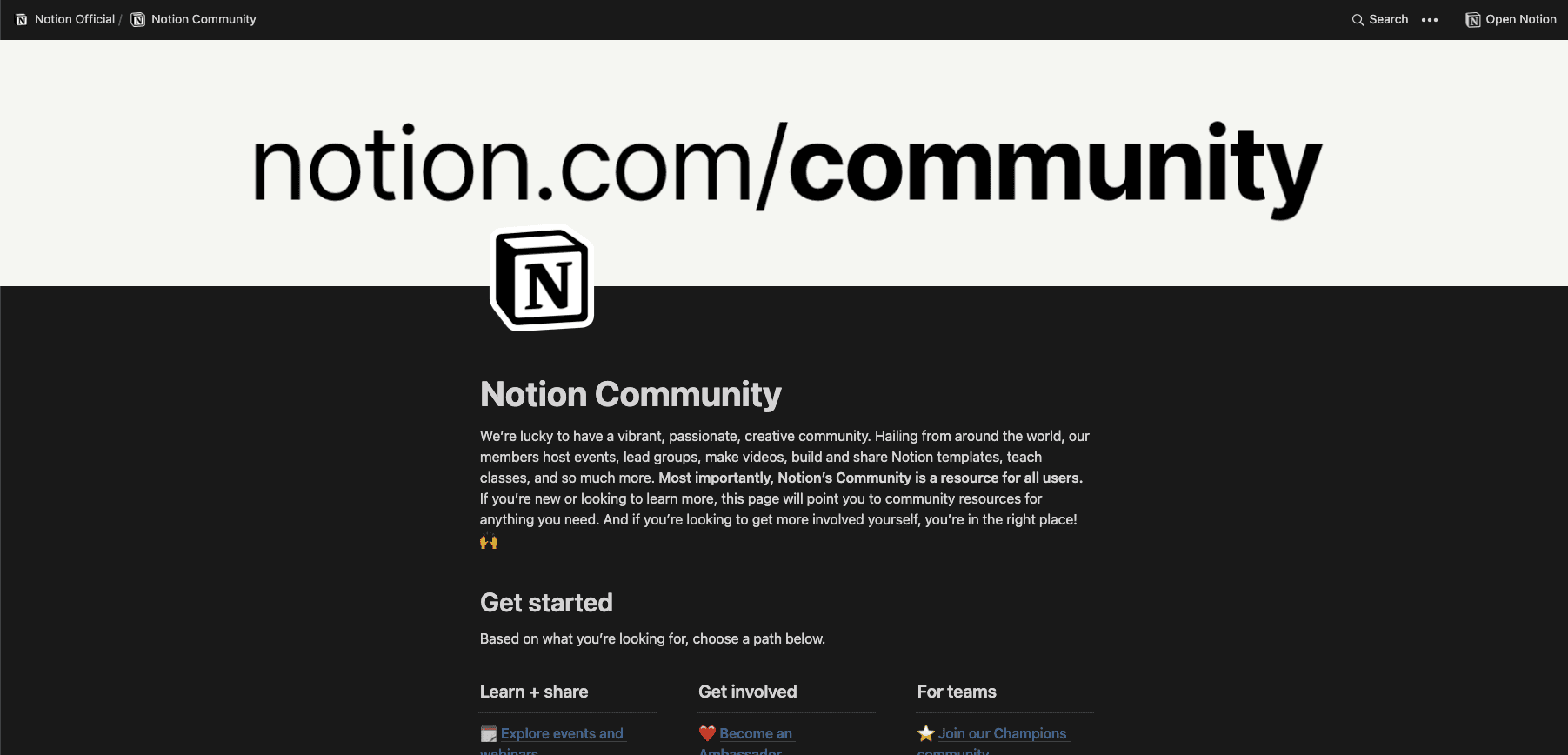
Activation: Grammarly’s product tour
When a new user logs into Grammarly, they’re asked a few simple questions about how they intend to use the platform. Next, they go through a quick, 4-step tour to see how the platform works, before a predefined document loads. Tooltips load to help the user edit the document in real time, shortening the learning curve and the time until value realization.

Retention: Canva’s weekly tips and design challenge
The stickiest products are platforms that customers log into as a part of their daily routine. To make this happen, you need to show your customers why they should log in frequently. For Canva, a part of this is educating customers on the huge number of features and functions within the platform.
Rather than overwhelm a new customer with options, they use a weekly tips drip campaign that shows the customer shortcuts, how-tos, and tips for working with the platform’s many features.
Canva also incentivize use with a #CanvaDesignChallenge where users can create something based on a theme or a brief for the chance to win a Canva prize pack and have your design featured on the Canva community.
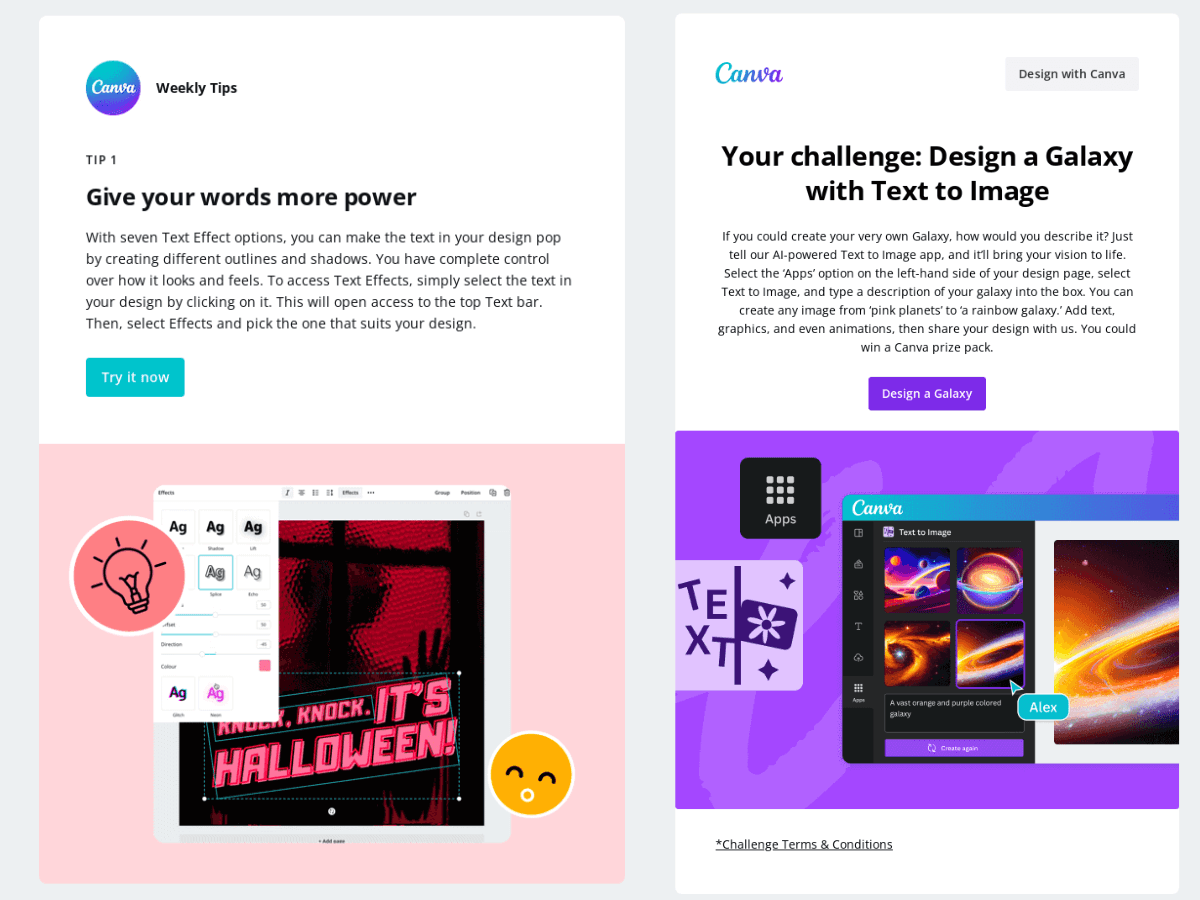
Referral: Dropbox’s referral program
Dropbox’s referral marketing example is one of the most-referenced examples in growth marketing for a reason. Dropbox identified something they could easily offer their customers — more space — and used it to create a powerful growth loop. They asked existing customers to refer their friends, and they would get 500MB of space for every referral who went on to become a customer. The referred person was granted the same reward, encouraging them to go on and refer their network.

Revenue: Monday for sales
Monday has a per-seat pricing model meaning to increase revenue with existing customers they would need to convince them to increase the number of seats they hold. This likely proved to be particularly difficult when the marketing, HR, and operations teams they targeted were retracting rather than expanding during and after the COVID-10 pandemic.
In what we can assume is a strategy to counteract this, Monday introduced Monday CRM in 2022. This opened up the opportunity for existing customers to add new seats to their plan for their sales and customer support representatives.
This is an example of market development at work. Rather than expanding their existing market or creating a new product, they took their existing product (with some feature additions) and branched out into a new, but closely related market.
Final word
Traditional marketing relies on top-of-the-funnel activities driving growth. Growth marketing plans look at the entire funnel, identifying how a business can grow through acquisition, activation, retention, referral, and revenue. It’s a more sustainable approach to growth that offers more opportunities for organic expansion and creates a more meaningful experience for customers.



